Fertiliser drills: What are the options?
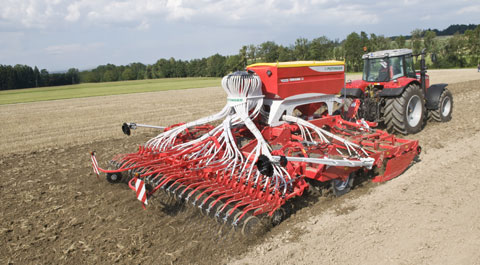
The technique of placing fertiliser at drilling time is moving out of its traditional stronghold in Scotland and northern England as growers in other parts of Britain look for ways of giving spring and winter crops alike an early nutrient boost.
Growers wanting to place fertiliser with grain used not to be too well catered for when it came to drill choice and capacity. But increased interest in this approach outside of those areas where it is a long-established technique has encouraged manufacturers to devise grain-and-fertiliser or combined drills of just about every configuration.
Arguments remain as to the best location for fertiliser in the soil. In Scotland, it has long been the norm for spring barley growers to put fertiliser down the spout.“It gets the crop away better to make use of a growing season that begins with short days and cold soil temperatures,” says Simon Brown of Amazone. “Putting NPK down the spout can also help prevent manganese deficiency.”
This technique is particularly helpful in making good use of phosphate because of its lack of mobility in the soil. Placing it in the row makes it readily available to encourage root development in search of a potential source of moisture.
Combined grain and fertiliser sowing can be used to partially feed the crop or – especially for spring sowings – apply the entire nitrogen requirement and avoid having to go on with a fertiliser broadcaster.
“The use of wider row spacing and increased min-till or direct sowing for oilseed rape is also seeing fertiliser applied on the drill,” adds Simon Brown. “Band application of a little starter N compensates for the loss of soil nitrogen caused by straw and crop residue decomposition, while adding phosphate helps root development.”
Putting fertiliser down the spout of a power harrow-seed drill combination is no great challenge – simply mount a hopper and metering system on the front of the tractor and feed it back to the coulters.
So what do the different manufacturers offer? Here’s a round-up.
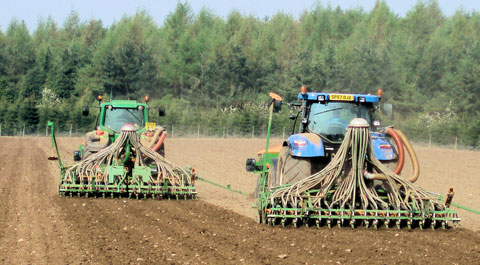 Amazone’s Avant 2,000-litre front hopper can be used as a stand-alone unit or mounted on a tyre press Amazone’s Avant 2,000-litre front hopper can be used as a stand-alone unit or mounted on a tyre press |
|---|
Kuhn Venta LC and NC – 3m + 4m with TF 1,500 front tank
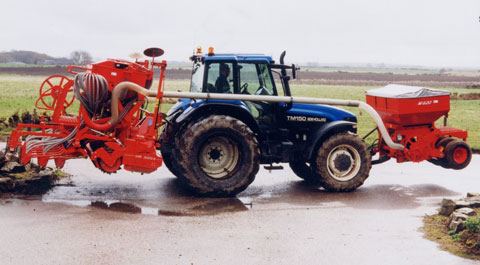 A TF 1500 front tank supplies fertiliser to this Kuhn Venta NC rear-mounted one-pass drill. The tank comes with a distribution mechanism that feeds fertiliser into the seed coulter, thereby placing it in the rows along with the seed. This adaption is possible on the LC and NC pneumatic seed drill/power harrow combinations in 3m and 4m sizes. A TF 1500 front tank supplies fertiliser to this Kuhn Venta NC rear-mounted one-pass drill. The tank comes with a distribution mechanism that feeds fertiliser into the seed coulter, thereby placing it in the rows along with the seed. This adaption is possible on the LC and NC pneumatic seed drill/power harrow combinations in 3m and 4m sizes. |
|---|
Lemken Solitair 9 – 3m, 4m, 5m + 6m with front tank
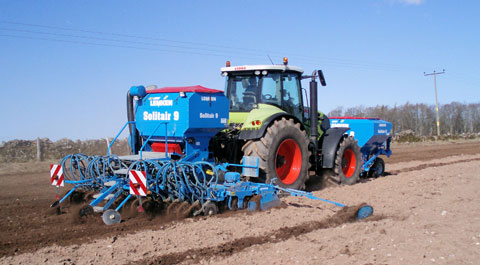 The Lemken Solitair / Zircon combination is usually supplied with a front tank for fertiliser application to growers in Scotland. The Solitair 9 also comes with a split tank option. The Lemken Solitair / Zircon combination is usually supplied with a front tank for fertiliser application to growers in Scotland. The Solitair 9 also comes with a split tank option. |
|---|
Kverneland Accord – 2.5m-4m with DF 1 or DF 2 front tanks
The Kverneland outfit comprises a divided 2,250-litre front hopper with press wheels and a metering/transfer system to the distribution head, which together with a rigid toolbar carrying double-entry Suffolk or CX disc coulters, is located on a 3m or 4m NG-S Pro power harrow.
Kverneland DF standalone front hoppers of 1,150-litre, 1,650-litre, 1,700-litre and 2,200-litre provide a similar facility for rear-mounted drills. The Kverneland Accord DFC 3m + 4m drills can also be used with a front tank
Disc coulter
Amazone Citan – 12m + 15m (works on cultivated ground)
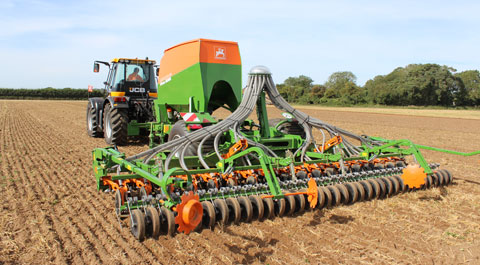 Amazone’s Citan 6000 solo drill comes with a 3,000-litre tank which can be divided for seed and fertiliser application. Dividers can be easily removed, meaning it can be converted quickly back to seed only. Metering is carried out via two separate gearboxes. Amazone’s Citan 6000 solo drill comes with a 3,000-litre tank which can be divided for seed and fertiliser application. Dividers can be easily removed, meaning it can be converted quickly back to seed only. Metering is carried out via two separate gearboxes. |
|---|
Great Plains V-300F – 3m (direct/mintill)
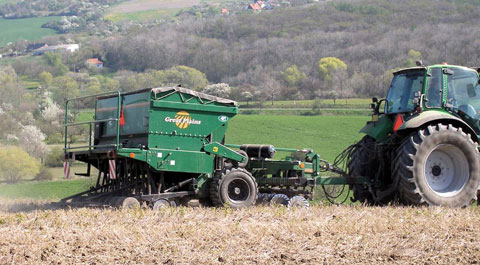 The Great Plains V-300F mechanical direct or mulch seeder comes with a hopper partition that can be set in one of nine different positions. There is also a seed and fert option on the Spartan 6m + 9m (direct/mintill) The Great Plains V-300F mechanical direct or mulch seeder comes with a hopper partition that can be set in one of nine different positions. There is also a seed and fert option on the Spartan 6m + 9m (direct/mintill) |
|---|
Sulky Easydrill Fertisem – 3m + 4m (direct/mintill)
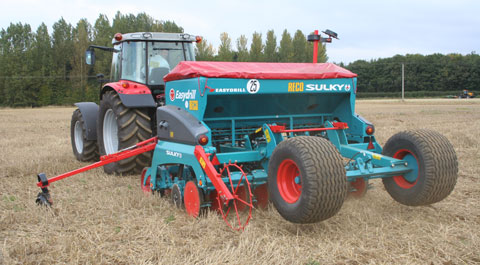 The Fertisem version of Sulky’s Easydrill has a partitioned hopper supplying seed to the regular disc coulters and fertiliser to a knife coulter to keep the two separate. The Fertisem version of Sulky’s Easydrill has a partitioned hopper supplying seed to the regular disc coulters and fertiliser to a knife coulter to keep the two separate. |
|---|
Tine coulter
Amazone Cayena-C – 6m
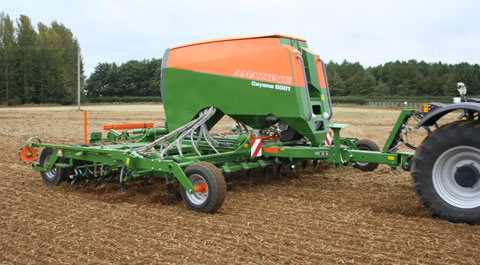 With minimum soil disturbance being seen as a way of combating problem grass weeds, Amazone anticipates increased use of tine drills like the Cayena, which is available in grain-only and grain/fertiliser formats. There are also seed and fertiliser options on the Primera DMC 6m + 12m and the Condor 12m + 15m machines. With minimum soil disturbance being seen as a way of combating problem grass weeds, Amazone anticipates increased use of tine drills like the Cayena, which is available in grain-only and grain/fertiliser formats. There are also seed and fertiliser options on the Primera DMC 6m + 12m and the Condor 12m + 15m machines. |
|---|
Horsch Sprinter ST – 3m-8m
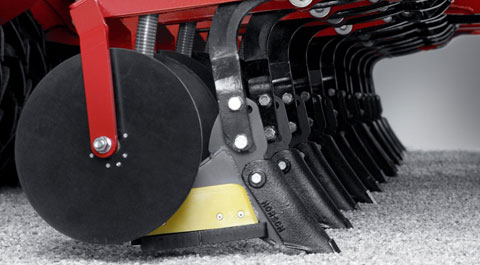 Solid or liquid fertiliser placement is available using the Duett coulter on Horsch’s Sprinter ST tine drills. “It deep loosens soil for the fertiliser, which is placed from behind the point, and it then creates a 30-40mm separation zone with seed placed on a firm seed-bed,” says Steve Burcham of Horsch. “The roots then go directly down into the fertiliser rather than down and to one side; it’s attracting increased interest among growers in England.” Solid or liquid fertiliser placement is available using the Duett coulter on Horsch’s Sprinter ST tine drills. “It deep loosens soil for the fertiliser, which is placed from behind the point, and it then creates a 30-40mm separation zone with seed placed on a firm seed-bed,” says Steve Burcham of Horsch. “The roots then go directly down into the fertiliser rather than down and to one side; it’s attracting increased interest among growers in England.” |
|---|
Väderstad Seed Hawk
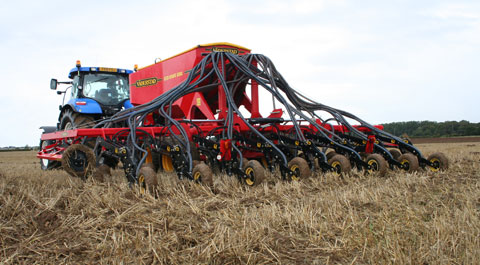 The Seed Hawk direct drill comes with the Combi hopper as standard to promote the benefits of an early feed in crops established using the no-till technique. Fertiliser is fed to the first of two knife tines on each coulter; the following knife places seed approximately 19mm above and 40mm to one side. The Seed Hawk direct drill comes with the Combi hopper as standard to promote the benefits of an early feed in crops established using the no-till technique. Fertiliser is fed to the first of two knife tines on each coulter; the following knife places seed approximately 19mm above and 40mm to one side. |
|---|
Disc cultivation
Horsch Pronto DC PPF 3m-6m
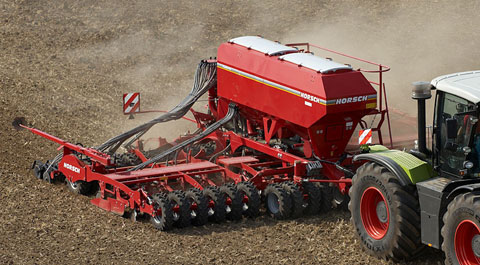 Horsch Pronto DC disc cultivating seeder uses a dedicated row of discs to place fertiliser between and a little deeper than the seed rows. Horsch Pronto DC disc cultivating seeder uses a dedicated row of discs to place fertiliser between and a little deeper than the seed rows. |
|---|
Horsch Pronto SW PPF 8m-12m
Horsch also has a placement system for the Pronto DC and SW disc cultivating drills that keeps seed and fertiliser segregated. “It uses a dedicated row of discs to place fertiliser between and a little deeper than the seed rows,” explains Steve Burcham of Horsch.
“It’s proving popular with spring barley growers for going straight on to ploughed ground.”
Pöttinger Terrasem R3 / C6 Fertilizer 3m + 6m
 Pöttinger Terrasem C6 Fertilizer trailed drill, with an extra row of discs to place granular ferts becomes available for next spring’s sowing campaign. Pöttinger Terrasem C6 Fertilizer trailed drill, with an extra row of discs to place granular ferts becomes available for next spring’s sowing campaign. |
|---|
Väderstad Spirit F 4m
Väderstad uses a banding system on the Spirit F Combi light-to-medium soil seeder to give the machine added versatility.“Fertiliser is delivered to steel tube coulters mounted on the arms that carry the system discs,” explains Andy Gamble of Väderstad. “Spaced 125mm apart, they place the fertiliser in a band approximately 25mm wide and 25mm deep.”
This approach avoids seed burn but delivers nutrition where and when required, he points out. It can be used for starter doses of N when sowing oilseed rape, as well as to under-sow cereal crops.
Väderstad Rapid 3m RD and 6m + 8m RDAC /b>
On the Rapid drills, fertiliser is “sown” using disc coulters that place the material between the seed rows and a little deeper. For seed-only drilling, the discs remain in work to add to the cultivation effect and can be raised to reduce draft and avoid unnecessary wear.
Väderstad Seed Hawk
 The Seed Hawk direct drill comes with the Combi hopper as standard to promote the benefits of an early feed in crops established using the no-till technique. Fertiliser is fed to the first of two knife tines on each coulter; the following knife places seed approximately 19mm above and 40mm to one side. The Seed Hawk direct drill comes with the Combi hopper as standard to promote the benefits of an early feed in crops established using the no-till technique. Fertiliser is fed to the first of two knife tines on each coulter; the following knife places seed approximately 19mm above and 40mm to one side. |
|---|
Tine cultivation
Horsch Focus TD 6m + 7m
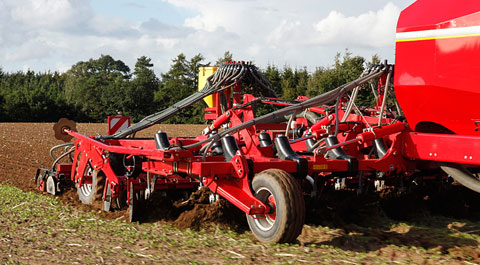 Adjustments on the Horsch Focus TD strip till drill enables fertiliser to be placed at different depths to suit the crop. Adjustments on the Horsch Focus TD strip till drill enables fertiliser to be placed at different depths to suit the crop. |
|---|
More information on combination drills

